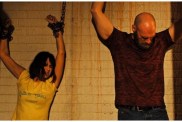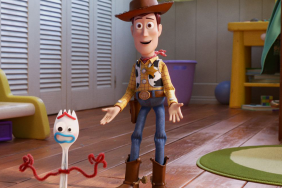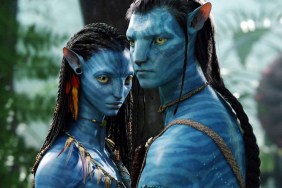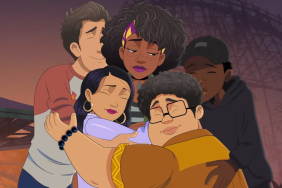Last year, ComingSoon.net was invited by Walt Disney Pictures to visit one of the sets being used for the upcoming Pirates of the Caribbean: At World’s End, that being the recreation of the much oft-mentioned Singapore where Johnny Depp’s Captain Jack Sparrow spends a lot of his time. This is also where we meet Chow Yun-Fat’s Captain Sao Feng as the various pirate crews unite to fight the East India Trading Company.
Here is CS correspondent Andrew Weil’s report from the visit:
The set that opens “Pirates of the Caribbean: At World’s End” took over the vast expanse of Stage 12 on the Universal Lot. Once home to the Penguin’s Lair in “Batman Returns,” this soundstage was home to the awe-inspiring re-creation of 18th Century Singapore for ‘Pirates 3.’
Built to scale, the incredibly-detailed Singapore set was incredible to walk through, built over a 3-foot deep pool of murky water giving the illusion of being held up by bamboo stalks, all with lit lanterns. There were 22 thatched structures actually built on stilts and numerous bridges linking together huts and a town center square, which featured an elaborate spice market next to a giant moat that allowed for great possibility for action sequences. The fireworks store that faced the spice market also set the scene for some explosive action. Every square inch of the set was cluttered with details, giving a very rich, full look to the city.
I even had a sense of fear crossing a very rickety bridge that, in the film, is used as a launching pad for East India Trading Company soldiers to attack our heroes. While I was not privy to what was filming that day of shooting, I did notice Geoffrey Rush wandering around the set practicing dialogue.
Disney also gave ComingSoon.net a chance to talk with production designer Rich Heinrichs about the design and construction of this particular set:
ComingSoon.net: How much warning did Gore Verbinski give you about having to construct 18th Century Singapore on a soundstage in L.A.?
Heinrichs: Well, you know, when it exists there as a word in a treatment, “Singapore,” well it’s a city, we know that, and then you do research on it. When the script’s not completed and you have no sense from the director of the action that needs to take place, you’re kind of creating and communicating to the director enough information that he actually is piecing a scene out of. It’s a lot of fun in these movies to have that kind of an influence over the direction the movie is going to take, come up with various ideas along the way that would provide physical comedy or action ideas to enhance it. You don’t often in films have the opportunity to give the sense of a whole community. I got to do it in “Sleepy Hollow” and “Lemony Snicket” and various other films that I’ve worked on. There’s something about a collection of structures that are related and yet all different and organically melded into a landscape. It’s such an amazing thrill to work on. Singapore is no different. In fact, it was a combination of water-based architecture, stilt houses or they’re called cantons in Southeast Asia, along with more land-based structures. We turned this whole stage, and it’s a fairly large stage, not huge but pretty good size, into this period urban environment that had so many different and interesting points of view and little pathways going from one place to another, so that the director was able to just turn the camera a little bit and get a completely different look in all these different directions. Whereas, when you stand there and look at the set, it’s this composite, but when you actually see it on film, it becomes larger if you will, and allow all different kinds of action. There were interior parts, there were tunnels with water in them, the stilt houses and bridges. It was one of those sets that is a fantastic set to visit, because it’s so unusual, and you look at it and go, “So this is what Hollywood is like.” It was the opposite of a green screen film.

CS: How closely did you work with Gore on the design of the set? Did he give you any sort of idea what he needed beforehand or did you just design something and then change it as he needed things?
Heinrichs: With Gore and with any director, it’s a chipping away process of kind of vague overarching concepts and what the set pieces will represent. The funny thing here was the fact that we were shooting the 2nd “Pirates” film while planning this major set for the 3rd film. The director is concentrating on all the action and characters and elements of the 2nd movie, and you’re trying to get his attention on this third movie that doesn’t come out for another couple of years. He knows he’s got to do it, but he’s got other stuff going on. What I had to do was kind of interesting. We built an eighth inch scale model of the set that we had to pack up in special boxes, and I had to fly it down to the Southern Caribbean, hoping that all the elements would come through in baggage and customs, find a place near Gore’s cabin on the island of Dominica, set-up the model again. I brought down my lipstick camera. We were just sort of way out there and I had all of my elements constructed from the art department, where we could actually could get into it and Gore could figure out what action was going to be taking place and what the characters that were going to be in that. It was one of those great moments of feeling that all of the tools that we bring to bear on what we do, we were able to bring down to Dominica. I got all the info I could from him at that time and went back, chopped away at the model and redesigned it and ten weeks later, we had a set.
CS: How has this compared to other sets you’ve done like for “Lemony Snicket” or the last Pirate movie?
Heinrichs: It’s different in the sense that
“Lemony Snicket” was fairly unusual in that it was a little bit more trying to have as many real textures and yet have an intentionally theatrical feel to it. These are more real adventures out there in the real world, getting as much in-camera as possible out on the location. Getting as much of what makes sense on stage. The visual effects that are added to it really are enhancements. They’re not creating the world. They’re simply filling out or adding onto it. I think that’s one of the great things about P2 is that it feels like this amazing adventure that the audience is in, and that they’re really out there and the visual FX are there to support that rather than simply to create something new completely.
CS: I’ve asked a few other production and set designers about this, but how does it feel when you create something huge and amazing like this, and eventually, you know that it has to be torn down? Essentially, it’s only being built for this one project and it has a finite life.
Heinrichs: I have young children, and I would guess it’s like when they have to go off to college and become adults. You sort of have to kiss it goodbye in your mind and think fondly of the good moments. Maybe that’s not the right metaphor (chuckles), but it is just one of the
we’re not building for museum storage, we’re building for the moment of actual filming. It’s just part of the process and all you want to do is make sure you’re recycling as much as you can and that you’re not being too wasteful. Hopefully, you’re only building what’s needed for filming and being as efficient as possible that way and that you’re being responsible about it. Then basically, you’ve just gotta turn your back on it and walk away.
Pirates of the Caribbean: At World’s End opens everywhere on May 25. Click here for more images from the anticipated film.









